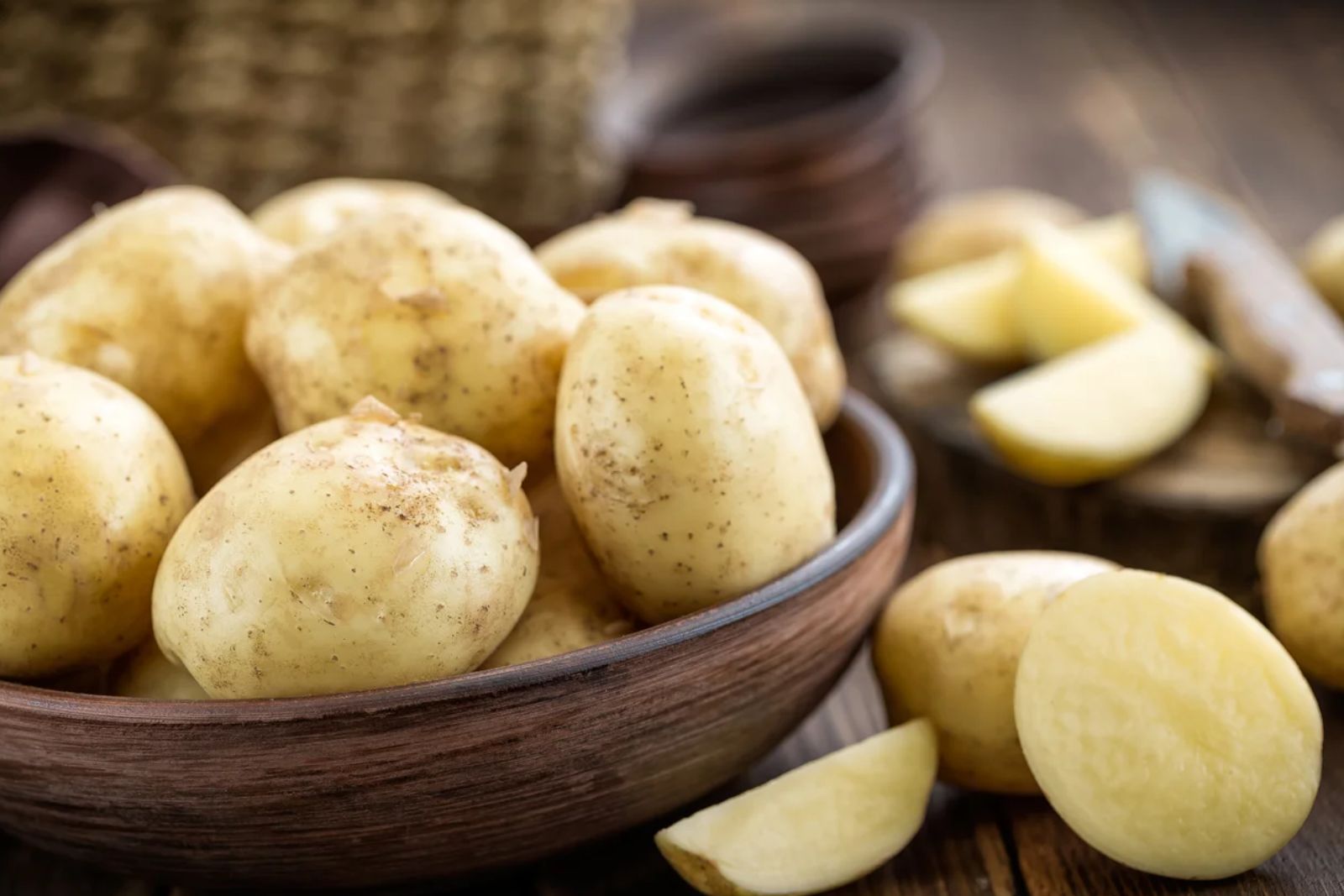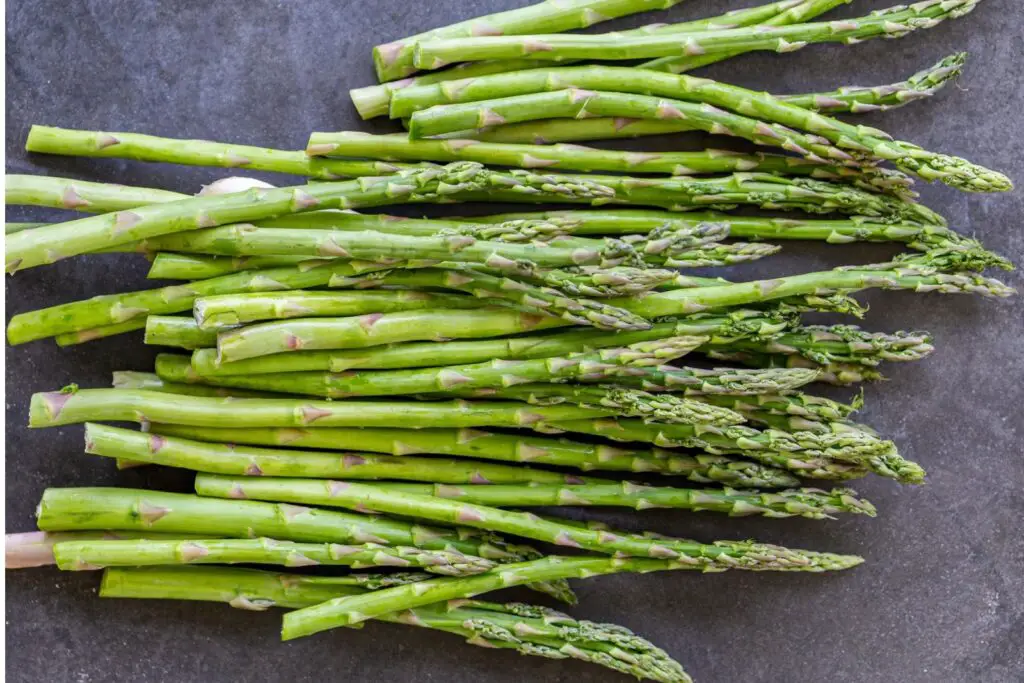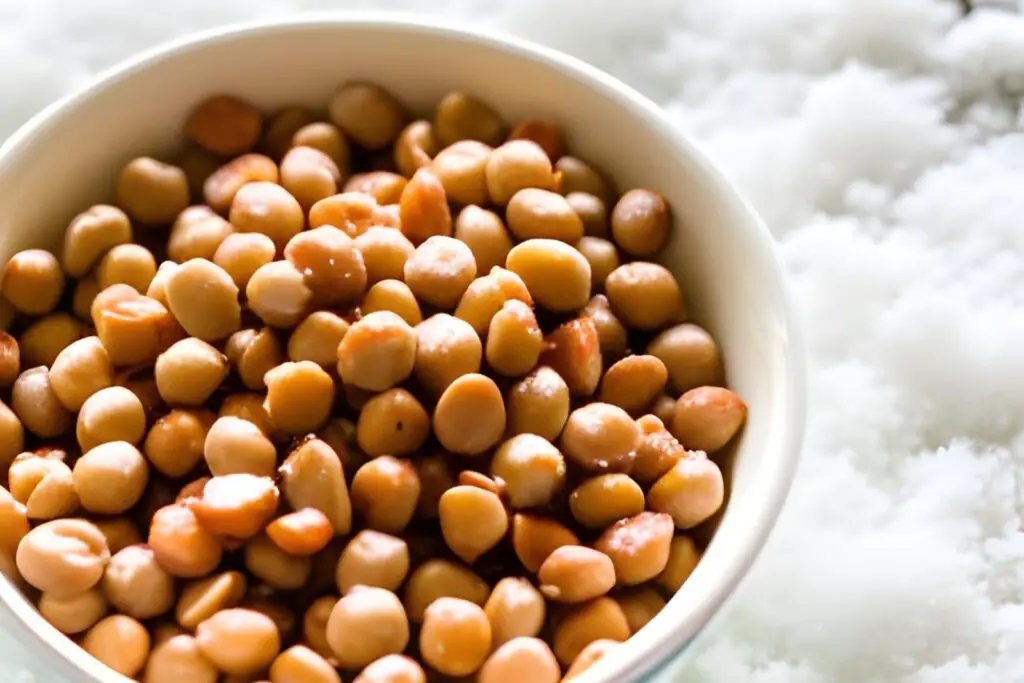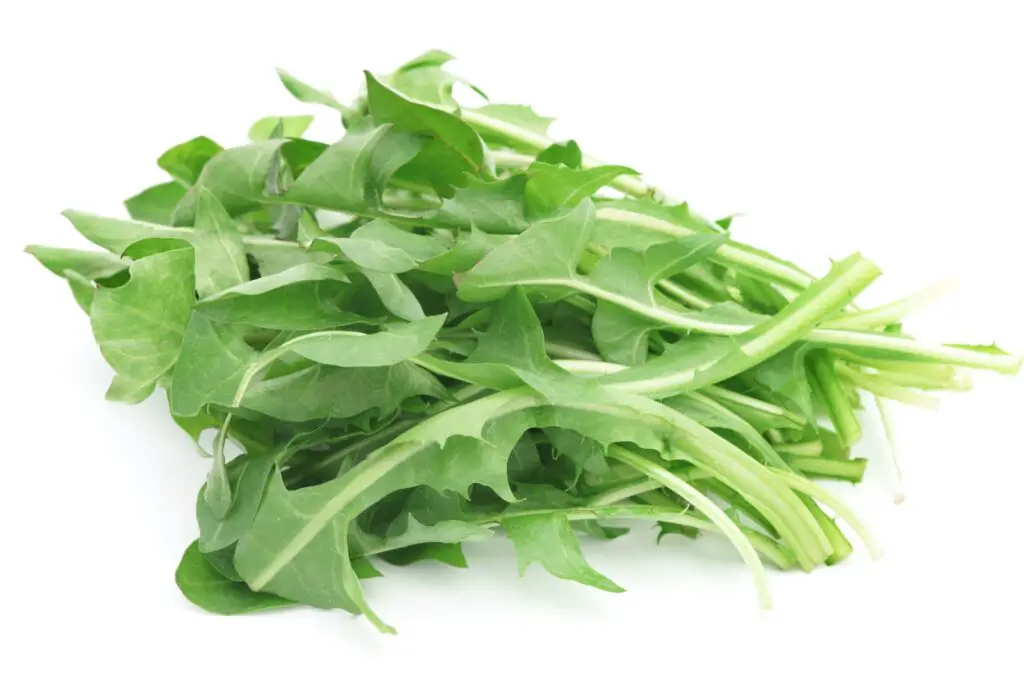
White potatoes are a versatile and popular vegetable, enjoyed by many in various dishes around the world. Their creamy texture and mild taste make them suitable for everything from mashed potatoes to roasted potato wedges. However, if you have an abundance of white potatoes or want to stock up during the harvest season, freezing them can be a great way to preserve their freshness and enjoy them throughout the year. Freezing white potatoes is a straightforward process that ensures they maintain their taste and texture. In this article, we’ll guide you through the steps of freezing white potatoes to ensure they remain delicious and ready for your culinary adventures.
Here’s a guide on how to freeze white potatoes:
- Step 1: Choose the right white potatoes
- Step 2: Clean and trim the potatoes
- Step 3: Blanch the white potatoes
- Step 4: Cool and dry the potatoes
- Step 5: Prepare the potatoes for freezing
- Step 6: Flash-freeze the white potatoes
- Step 7: Package and seal the potatoes
- Step 8: Label and date the packages
- Step 9: Store in the freezer
Step 1: Choose the right white potatoes
Choosing the right white potatoes is crucial when preparing them for freezing. Freshness and quality play a significant role in determining the success of the freezing process and the taste of the potatoes when you decide to use them later. Here’s why selecting the appropriate white potatoes matters:
- Freshness and taste: Fresh white potatoes have a better taste and texture compared to older ones. By choosing firm and healthy potatoes, you ensure that the natural flavors of the vegetable are preserved during freezing.
- Avoiding spoiled potatoes: Potatoes with mold, soft spots, or sprouts are signs of deterioration and spoilage. Freezing such potatoes can result in further degradation, leading to an unpleasant taste and texture in the final dish.
- Texture after thawing: Larger white potatoes tend to hold up better during the freezing and thawing process. Smaller potatoes might become mushy or lose their texture when frozen, affecting their usability in dishes.
- Consistency in freezing: Using potatoes of similar size and quality ensures a more uniform freezing process. This consistency makes it easier to manage the freezing time and avoid overcooking or undercooking during blanching.
Step 2: Clean and trim the potatoes
Cleaning and trimming white potatoes before freezing is an essential step to ensure that they are free from any contaminants and to enhance their appearance and quality during the freezing process. Here’s why cleaning and trimming are important:
- Removing dirt and debris: White potatoes, like many root vegetables, grow underground, and they can accumulate dirt, mud, and other debris on their surface. Washing them under cold running water helps remove these impurities, making the potatoes clean and ready for further processing.
- Maintaining hygiene: Properly cleaning the potatoes ensures that any bacteria or pathogens present on the surface are washed away. This helps prevent foodborne illnesses and ensures that the frozen potatoes remain safe for consumption.
- Enhancing visual appeal: Cleaning the potatoes improves their appearance, making them more visually appealing when they are served later in dishes. The removal of dirt and blemishes makes the frozen white potatoes look more appetizing.
- Trimming blemishes and eyes: Some white potatoes may have small blemishes, bruises, or “eyes” (small sprouts) on their skin. Trimming off these imperfections not only improves the appearance but also helps prevent potential spoilage points during freezing.
- Even blanching and freezing: Having uniformly clean and trimmed potatoes ensures that they blanch evenly, providing a consistent texture and taste after freezing. It also allows for more efficient use of freezer space and prevents uneven cooking when you decide to use the frozen potatoes in recipes later on.
Can I freeze white potatoes with skins on?
Yes, you can freeze white potatoes with skins on. The skins help protect the potatoes during freezing and contribute to their overall texture. However, it’s essential to wash and clean the potatoes thoroughly before freezing to remove any dirt or debris.
Step 3: Blanch the white potatoes
Blanching is a vital pre-freezing process that involves briefly boiling the white potatoes before freezing them. This step is essential for several reasons:
- Enzyme deactivation: White potatoes naturally contain enzymes that can cause browning and texture changes when exposed to air or during freezing. Blanching in boiling water deactivates these enzymes, helping to preserve the potatoes’ color and texture during freezing.
- Microbial reduction: Blanching helps to reduce the number of bacteria present on the surface of the potatoes. While it does not completely sterilize them, it significantly lowers the microbial load, reducing the risk of spoilage and foodborne illnesses during storage.
- Softening the texture: By blanching, the cell walls of the potatoes are partially softened, which makes it easier for water and air to escape during freezing. This helps to prevent ice crystals from forming inside the potato cells, reducing the risk of cell rupture and maintaining a better texture when thawed and cooked.
- Preserving nutrients: Blanching is a brief process, so it helps retain most of the vitamins and minerals in the white potatoes. It allows you to enjoy the frozen potatoes with a higher nutrient content compared to other preservation methods that may involve longer cooking times.
- Even cooking: Blanching ensures that the potatoes are partially cooked before freezing, promoting even cooking when you decide to use them in recipes later on. This way, you can avoid unevenly cooked portions in your dishes.
The recommended blanching time varies based on the size of the white potatoes. Smaller ones may require only a few minutes, while larger ones need a bit more time to ensure they are properly blanched. Timing is crucial, and starting the blanching countdown after the water returns to a boil ensures that all the potatoes are subjected to the proper blanching duration.
Can I freeze white potatoes without blanching them first?
Blanching is a crucial step in the freezing process as it helps preserve the texture, color, and nutrients of the potatoes. Skipping blanching may result in poor-quality frozen potatoes with compromised taste and texture.
Step 4: Cool and dry the potatoes
After blanching the white potatoes, it’s essential to cool them down quickly and dry them thoroughly before proceeding with the freezing process. This step is crucial for several reasons:
- Halting the cooking process: Placing the blanched potatoes in an ice water bath rapidly lowers their temperature, stopping the cooking process. This helps prevent overcooking, ensuring that the potatoes retain their desired texture and don’t become mushy.
- Preserving color and nutrients: Cooling the potatoes quickly after blanching helps lock in their vibrant color and preserve their essential nutrients. This prevents further enzymatic activity that could lead to color changes and nutrient loss during freezing.
- Preventing bacterial growth: Cooling the potatoes promptly inhibits bacterial growth, reducing the risk of spoilage and foodborne illnesses during storage.
- Enhancing freezing efficiency: Drying the blanched potatoes after the ice water bath removes excess moisture on the surface. This is essential for the freezing process as excess moisture can lead to the formation of ice crystals, which may affect the texture of the potatoes.
- Preventing ice clumping: Dry potatoes freeze more efficiently and are less likely to clump together during freezing. Individual frozen pieces allow for easy portioning and usage in future recipes.
The ice water bath is an effective method to cool down the blanched potatoes rapidly. It involves submerging the potatoes in a bowl of ice-cold water, which absorbs the heat and cools the potatoes within minutes.
After cooling, gently patting the potatoes dry with paper towels or a clean kitchen cloth removes any remaining moisture. Ensuring the potatoes are dry before freezing reduces the risk of freezer burn and maintains the overall quality of the frozen product.
Step 5: Prepare the potatoes for freezing
At this stage, you have the flexibility to choose how you want to freeze the blanched and cooled white potatoes based on your culinary preferences and intended uses. Each freezing method offers distinct advantages and is suitable for different types of dishes. Here’s an explanation of the various options:
- Freeze them whole: Freezing whole white potatoes is a straightforward approach. It works well if you plan to use the potatoes for roasting, baking, or boiling. Freezing them whole preserves their natural shape and texture, making them convenient for dishes where you want intact potatoes.
- Slice them: Slicing the white potatoes before freezing is beneficial if you envision using them for dishes like scalloped potatoes, potato gratin, or sautéed potatoes. Sliced potatoes thaw more quickly and evenly, allowing for faster cooking times in these recipes.
- Dice them: Dicing the white potatoes is a versatile option suitable for a wide range of dishes. Frozen diced potatoes are excellent for making stews, soups, hash browns, or skillet meals. They cook quickly and evenly, making them convenient for recipes where consistent sizing is desirable.
- Mash them: Mashed white potatoes can be frozen in portions, allowing you to enjoy creamy mashed potatoes even when fresh potatoes are not readily available. Freezing mashed potatoes is perfect for side dishes or incorporated into other recipes like shepherd’s pie.
Regardless of the method you choose, it’s essential to prepare the white potatoes for freezing in a way that best suits your cooking preferences and the dishes you plan to create in the future. Remember to store the prepared potatoes in a manner that is convenient for your intended usage.
Before proceeding to freeze the white potatoes in your chosen form, ensure that they are adequately cooled and dried to prevent the formation of ice crystals. Additionally, consider portioning them into suitable serving sizes for easy meal planning and usage.
Step 6: Flash-freeze the white potatoes
Flash-freezing is a technique used to individually freeze items quickly and efficiently. It is particularly useful for freezing small pieces or items that could otherwise stick together, such as white potatoes, berries, or sliced vegetables. When it comes to freezing white potatoes, flash-freezing helps maintain their individual shape and prevents them from clumping together during storage. Here’s why flash-freezing is an important step in the freezing process:
- Preventing sticking: When foods freeze slowly or in large clumps, they can stick together, making it challenging to separate them when you need to use a portion. Flash-freezing ensures that each white potato freezes individually, preventing them from becoming a solid mass in the storage container.
- Maintaining quality: By freezing the white potatoes quickly, the formation of large ice crystals is minimized. Large ice crystals can damage the cell structure of the potatoes, affecting their texture and overall quality. Flash-freezing helps preserve the potatoes’ integrity and ensures they retain a better texture after thawing.
- Reducing freezer burn: Flash-freezing decreases the chances of freezer burn, which occurs when air comes into contact with the frozen food. Properly flash-frozen white potatoes have less exposure to air, minimizing the risk of freezer burn and helping them stay fresher for longer.
- Easy portioning: Individual frozen white potatoes allow for easy portioning, making it convenient to take out only the amount you need for a particular recipe or meal without thawing the entire batch.
To flash-freeze the prepared white potatoes, it’s important to lay them out on a baking sheet in a single layer. This arrangement ensures that each potato receives uniform freezing. Placing the baking sheet in the freezer allows the potatoes to freeze quickly and efficiently.
After a few hours of flash-freezing, the white potatoes should be partially frozen but not entirely solid. At this point, you can proceed to the next step of packaging and storing them in airtight freezer-safe containers or bags. The partially frozen potatoes won’t stick together, making it easy to remove individual pieces whenever you need them.
Step 7: Package and seal the potatoes
Proper packaging and sealing are essential steps in the freezing process to ensure that the white potatoes remain fresh, free from freezer burn, and maintain their quality during storage. Here’s why packaging and sealing are crucial:
- Preventing freezer burn: Freezer burn occurs when air comes into contact with the frozen food, causing moisture to evaporate and leading to dehydration. This can result in a change in texture, flavor, and overall quality of the frozen white potatoes. Airtight packaging helps create a barrier that prevents air from reaching the potatoes, reducing the risk of freezer burn.
- Maintaining freshness: Packaging the partially frozen white potatoes in airtight containers or bags helps retain their natural flavors and prevents them from absorbing any unwanted odors from other items in the freezer.
- Easy storage and organization: Using proper freezer-safe containers or bags allows for efficient use of freezer space and easy organization. You can stack or arrange the containers neatly, making it convenient to find and retrieve the white potatoes when needed.
- Avoiding cross-contamination: Airtight packaging also prevents cross-contamination with other foods in the freezer. This is especially important when storing raw white potatoes alongside other frozen items to avoid any potential bacterial transfer.
To package and seal the partially frozen white potatoes:
- Transfer them into airtight containers: Choose freezer-safe containers that are appropriate in size for your portioning needs. Glass, plastic, or rigid plastic containers with secure lids work well for this purpose.
- Use heavy-duty freezer bags: Alternatively, you can place the partially frozen white potatoes in heavy-duty freezer bags, which allow for flexibility in portioning and save space in the freezer.
- Remove excess air: Before sealing the containers or bags, try to remove as much air as possible. Press down gently on the bags or containers to push out excess air before sealing. This step minimizes the chance of freezer burn by reducing air exposure.
Can I reuse the same freezer bags or containers for freezing potatoes?
Reusing freezer bags and containers is possible, but they should be thoroughly cleaned and sanitized before each use. Ensure there are no residues or odors that could affect the taste and quality of the frozen white potatoes.
Step 8: Label and date the packages
Labeling and dating the packages of frozen white potatoes is a simple yet crucial step in the freezing process. This practice helps you maintain better organization in your freezer and ensures that you can enjoy the white potatoes while they are still at their best quality. Here’s why labeling and dating are essential:
- Easy identification: When you label each container or bag with the contents (in this case, white potatoes) and the date of freezing, you can quickly identify what’s inside without having to open or guess. This is especially helpful when you have multiple frozen items in your freezer.
- Rotation and usage: By dating the packages, you create a system for using the oldest potatoes first. This practice encourages proper rotation of your frozen food inventory, ensuring that you consume the older batches before moving on to newer ones. It helps avoid the problem of forgotten or wasted items in the freezer.
- Optimal quality: Over time, frozen foods may experience a decline in quality, such as texture changes or a decrease in flavor. By dating the packages, you can keep track of how long the white potatoes have been in the freezer and prioritize using them before any significant loss in quality occurs.
- Reducing food waste: Proper labeling and dating allow you to use the frozen white potatoes within a reasonable timeframe, minimizing the risk of them being forgotten and ultimately wasted. This helps you make the most of your stored produce and reduce food waste.
To effectively label and date the packages:
- Use permanent markers: Use a permanent marker to write the contents (“White Potatoes”) and the date of freezing on the containers or bags. Make the labels clear and visible for easy identification.
- Place the labels prominently: Position the labels where they are easy to see without having to move other items in the freezer. Placing them on the front or top of the containers/bags is usually the most convenient.
- Maintain a record: If you have several packages of frozen white potatoes, consider keeping a record of the dates in a freezer inventory list. This record can help you stay organized and plan your meals accordingly.
Step 9: Store in the freezer
Storing the labeled and properly packaged white potatoes in the freezer is the last step in the freezing process. This step is critical for ensuring that the white potatoes remain safe to eat and maintain their quality over an extended period. Here’s why proper freezer storage is essential:
- Temperature control: The coldest part of the freezer is ideal for storing frozen foods like white potatoes. Freezers set to 0°F (-18°C) or lower are the safest and most effective for long-term storage. This low temperature helps preserve the texture, flavor, and nutritional value of the white potatoes.
- Avoiding temperature fluctuations: Fluctuations in freezer temperature can cause ice crystals to form and melt, leading to freezer burn and reduced quality in the frozen potatoes. Placing the potatoes in the coldest part of the freezer helps maintain a steady and consistent temperature, reducing the risk of freezer burn.
- Long-term storage: Properly frozen white potatoes can last for up to 10-12 months when stored at the correct temperature. During this time, they should remain safe to eat and retain their taste and texture, allowing you to enjoy them throughout the year.
- Organized freezer: Storing the labeled packages in an organized manner ensures that you can easily access the white potatoes whenever you need them. Keeping the freezer tidy and well-arranged helps prevent items from getting lost or forgotten, reducing the chance of food waste.
To store the frozen white potatoes:
- Place the labeled packages in the coldest part of the freezer, such as the back or bottom shelf. Avoid placing them near the freezer door, as this area experiences more significant temperature fluctuations.
- Leave sufficient space around the packages to allow cold air to circulate freely. Crowded freezer storage can lead to uneven freezing and potential quality issues.
- Keep a freezer inventory list or use a “first-in, first-out” approach to ensure you use the oldest packages of white potatoes first.
- Always close the freezer door tightly to maintain a consistent temperature inside the freezer.
Other related questions
How do I thaw frozen white potatoes?
To thaw frozen white potatoes, transfer them from the freezer to the refrigerator and allow them to thaw slowly for several hours or overnight. For a quicker thaw, place the potatoes in a sealed plastic bag and immerse them in cold water, changing the water every 30 minutes until fully thawed. Avoid using hot water or thawing at room temperature to prevent foodborne illness.
Can I refreeze white potatoes?
It is generally safe to refreeze white potatoes if they were thawed in the refrigerator and cooked before the second freezing. However, repeated thawing and refreezing can affect the quality and texture of the potatoes, potentially leading to a loss of taste and nutritional value. To maintain the best quality, it’s advisable to use the thawed white potatoes within a reasonable timeframe after their initial thawing.
How do I know if the white potatoes have gone bad after being frozen?
To determine if frozen white potatoes have gone bad, look for signs of freezer burn, such as dry or discolored patches on the surface. Bad potatoes may also have a foul smell or unusual texture, such as being mushy or slimy. If any of these signs are present, it’s best to discard the potatoes to avoid potential foodborne illness and ensure safe consumption.
Can I freeze cooked white potatoes?
Yes, you can freeze cooked white potatoes. Allow them to cool completely, then package and freeze them as you would with raw potatoes. Cooked frozen potatoes are convenient for quick meals and side dishes.
Should I add any seasoning or spices before freezing white potatoes?
It’s best to avoid adding seasoning or spices before freezing white potatoes. Unseasoned potatoes freeze more effectively and provide greater flexibility in using them for various dishes later on. You can add seasonings and spices when you cook the potatoes after thawing.








